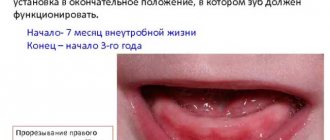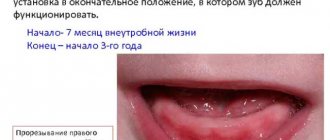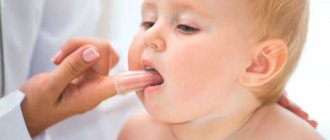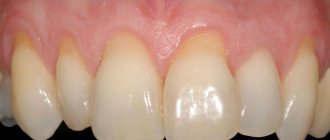What reaction is possible for a baby when teething?
What reaction can a child have when baby teeth appear? During this period, children may react in different ways:
- Some children tolerate this period quite normally. The only symptom that worries them is itching in the gums, increased salivation and a slight increase in body temperature.
- Other babies react very hard to teething: the temperature may rise to 38-39 degrees, they do not sleep at night, and refuse to eat.
- There are also little ones who are luckier than others: their teeth appear without any problems and almost imperceptibly.
How many teeth does a 9 month old baby have?
Babies cut their first teeth - the lower front incisors - at the age of 6-8 months. After 1-2 months, two opposing upper incisors will appear. This is an accepted norm, but only approximate. Some babies are born with teeth, while others join the ranks of teethers only at 12-15 months.
Be that as it may, sooner or later the first tooth will come out, followed by the rest, and the mother needs to be prepared for her child’s red and swollen gums, poor sleep, whims and loss of appetite - these are the most common symptoms of teething. You can alleviate the unpleasant sensations: you definitely need to give the baby something to chew on - a teether, a bagel or an apple.
What causes the temperature to rise during teething in children?
When babies erupt their first teeth, 2 processes occur that are interconnected:
- In the oral cavity, local immunity decreases, which is why a secondary infection may occur. Stomatitis, sore throat, pharyngitis and other diseases can often occur.
- At the site of tooth growth, the production and release of many biologically active substances necessary for softening the gums occurs.
- Inflammation of the gums and reduced immunity often provoke a protective reaction of the body - body temperature rises to 37-37.5.
In infants, when teething, the body temperature should not be higher than 37.5 degrees (the so-called low-grade fever).
During this period, it is necessary to carefully monitor the general condition of the baby. There are children who tolerate this temperature quite normally. And for others, help is needed in order to survive such an unpleasant period. Sometimes children may be bothered by a slight increase in it, they may cry, be capricious, refuse to eat, or not sleep at night.
Important: keep in mind that if a baby experiences an increase in body temperature to 38-38.5 °C, consult a doctor immediately. In no case should you attribute everything to your teeth, as such a symptom may indicate an additional infection or inflammatory process.
How long during teething do children usually have a fever? Normally this is no more than 1-3 days. Most often it rises at night, does not exceed 38 degrees and is easily knocked down.
Important: if your little one has a fever for more than three days, the temperature is above 38 degrees and does not go down well, seek medical help immediately.
The period of active growth and weight gain continues
At nine months, your baby will still look like a baby—with a big head, chubby legs and arms, and an adorable belly. As he begins to move more and test his strength in standing and walking, the outline of the child's figure will begin to change.
According to Russian pediatricians, on average at nine months your baby will have:
- weight gain per month of 500 g, weight up to 8600-9000 g;
- height increase per month of 1.5 cm, height approximately 74 cm;
- head circumference - 44.5-45.5 cm;
- chest circumference - 46.5-47.5 cm.
Why is high temperature dangerous for a child and when should you sound the alarm?
High temperature (39-40 degrees) is extremely dangerous for children in their first year of life. Because of this, disruption of the central nervous system and heart, and convulsions are possible. A rapid increase over several hours and one that is difficult to bring down with antipyretics is very dangerous.
As a result of a sharp increase, the temperature center of the brain is not able to withstand such a load, which can cause seizures. Children with central nervous system pathology are at risk. They cannot be risked, and the temperature must be brought down as soon as it has already risen to 37.5 degrees.
What to do if your child has a fever?
If, when teething, the child is restless, asks to be held, or cries, there is no need to worry. All parents go through this, you are not the first and you will not be the last. It is much worse if the baby does not react to anything, constantly sleeps and behaves very calmly. When the temperature rises, this is an alarming signal.
In this case, monitor your child with special attention and measure the temperature every hour. This can be done in the crease near the groin or armpit. To do this, it is better to use an electronic thermometer: it will be able to show you the result much faster than a mercury thermometer, in addition, it is more accurate. It is also safer and cannot be broken.
If the child’s temperature cannot be measured this way, it can be done rectally. To do this, lubricate the tip of the thermometer with baby cream, then carefully insert it into the rectum. Pinch the child's buttocks and wait for a signal indicating that the measurement is complete.
Important: when measured in the rectum, the values will always be higher compared to those in the armpit. The norm is a temperature within 37-37.5 degrees. Once you get a score of 38.5 or higher, be sure to shoot it down.
How do you know if your baby is unwell? There are signs that indicate a condition where high fever is dangerous:
- The skin feels dry and hot to the touch.
- Lips become dry.
- Eyes sparkle.
- Cheeks turn red.
- The baby rarely urinates.
If you see them, remember that urgent help is needed, because this condition is extremely dangerous for the child’s body.
What complementary foods does a 9 month old baby eat?
The diet of a 9-month-old baby is already quite varied. Your baby can continue to receive breast milk and/or formula and complementary foods. The products will no longer include only cereals, vegetables, meat and dairy products, but also bread, butter and vegetable oil, and fish. And in order not to harm the baby, when switching to a “common table”, mothers adhere to the scheme for introducing complementary foods
— the table contains recommended foods for feeding and portion sizes per day depending on the child’s age. Complementary feeding introduced in a timely manner will become the basis for proper nutrition and good appetite even for small children.
What else should you pay attention to?
If you are no longer breastfeeding or your baby has been bottle-fed since birth, we advise you not to rush into introducing whole cow's milk and the milk of other animals. Let only baby formula remain in the diet for now, since it is adapted to the physiological characteristics of the digestion of babies, which means it is easier to digest.
Among MAMAKO® baby food there are mixtures for children in the second half of life, and complementary feeding products for a baby at nine months (including for nutrition with a tendency to allergies). Buckwheat and corn porridge, 5-grain porridge and cream soups of pumpkin and spinach with goat's milk, fruit puree with goat's curd - all these are complementary feeding options allowed by pediatricians for children under one year old.
From 6 months to 2 years, young children are especially open to new taste sensations. And mother can help her baby develop them. How? Try offering your child multi-ingredient cereals. For example, buckwheat porridge with apple and carrots. Many kids are very curious about new and varied tastes and eat such treats with pleasure.
Five factors that influence how long you wear braces
The total time that patients wear braces is 1-3 years. How many months or years it will take in your case can only be predicted by an orthodontist (after examination and medical history). In advance, you can independently calculate the approximate time for which the structures are worn, taking into account five main factors:
- Patient's age.
- Type and complexity of violations.
- Type of bracket system.
- Qualification of an orthodontist.
- Care and implementation of recommendations.
Each of the factors has its own characteristics, which are worth considering in more detail.
Patient age
The specific time of use after installing braces is determined based on the clinical picture and individual characteristics of the jaw structure. But, you can rely on average data that is natural for different ages of patients:
- Children
. Due to the pliability of the dentofacial apparatus, which occurs at the age of 12-16 years, all processes to correct the bite occur quite quickly. Most often, 0.5-1 year is enough to correct moderate severity. - Teenagers
. During the period of active formation of the dental system, you can count not only on the effectiveness of the result, but also on the minimum time to achieve it. On average, adolescents aged 18-23 years need 3-8 months less to achieve the desired result than older patients. - Adults
. Since in an adult the dentofacial apparatus is already fully formed, regenerative processes in tissues are slowed down and the rate of metabolic processes decreases, orthodontic treatment will take 2-3 years.
The question of how long braces should be worn may also arise in older people - the use of these orthodontic structures can be shown as one of the preparatory stages before prosthetics. In this case, you will have to wear braces for several years.
Type and complexity of violations
Braces can solve a number of problems with bite and uneven teeth. Depending on the reasons why you are installing orthodontic structures and the severity of the defect, the time for using braces may vary:
- Alignment of one or more teeth
. If it is necessary to shift (change the position) of units in a row, you will have to wear braces for an average of 1.5 years. - Elimination of distal bite
. This pathology can be diagnosed with different stages of complexity. Depending on the severity of the defect, wearing orthodontic structures lasts 1-3 years. - Elimination of diastema
. If the gap between the incisors is not a cosmetic defect and does not require masking (for example, with veneers), but treatment, then the doctor will prescribe braces. How long it takes depends on the age of the patient. The average period is 1-2.5 years. - Correction of deep bite
. One of the most difficult cases that braces can solve. In childhood this will take about 1.5 years, and for adults – up to 3 years.
In the case of crowded teeth, dystopia and other dental defects that require the use of braces to resolve, the time frame is determined individually and varies between 1.5-3 years.
Type of bracket system
The chosen type of braces also influences how long to wear orthodontic systems:
- By material
:
Metal
. The strongest modern system that applies optimal pressure to tissue. It is used to correct even complex defects within a period of 1-1.5 years. - Plastic
. They are fragile and require the utmost care. You will have to wear these braces for 12-18 months. - Ceramic
. Durable and do not cause allergies. Used to correct simple defects. Requires extended wear time - up to 3 years. - Sapphire
. They require particularly careful oral care. The impact of such systems lasts 1.5-3 years.
:
- Lingual
. They are attached to the inner surface of the teeth. Used for 1.5-2.5 years.
. They are attached to the outer surface of the teeth. Used for 1-2 years.
:
- Ligatures
. The design allows you to work more accurately and with greater force on difficult areas. Accordingly, the wearing time is as short as possible - up to 1.5 years.
. They are worn longer than ligature ones - up to 2.5 years. This option is chosen by those who, while wearing braces, care about the aesthetics of their smile, and who are willing to sacrifice extra time wearing the system for the sake of beauty.
Most often, patients are shown several options for braces, from which they can choose the one that suits its appearance and price. Not the last factor will be how long you will have to wear braces and whether you are willing to deliberately increase the wearing time for the sake of aesthetics or want to correct the defect in the shortest possible time.
Qualification of an orthodontist
The time that you will have to wear the brace system and obtaining the desired result directly depend on the experience and qualifications of the specialized doctor:
- At the consultation stage
. It is important to get the right advice on choosing a brace system based on your clinical case. Not only indications, but also contraindications should be taken into account. - At the preparation stage
. A lot depends on the quality of taking impressions and setting the task for the laboratory specialist. Only an experienced orthodontist will be able to do all the preparatory steps correctly. - At the installation stage
. The braces themselves are attached strictly to certain places and at a certain angle - depending on the position and inclination of the teeth. The doctor’s lack of relevant experience will increase the time of wearing the orthodontic structure and will not give the desired effect of treatment at all.
By choosing the right clinic and specialist, you increase your chances of getting a perfect smile and a healthy bite as quickly as possible.
Care and implementation of recommendations
Keep in mind that how long you need to wear braces depends on your responsibility. For example, a late visit to change wires may stop or slow down treatment. And an irresponsible attitude towards oral hygiene can lead to the development of caries and other diseases, which will require immediate solutions to problems. And, since braces can interfere, they will have to be removed, reducing to zero all the results achieved so far. The chipping of one of the braces can also increase the wear time - while the analogue is being made, the result will slow down or stop altogether.
Not only failure to follow the recommendations of an orthopedic dentist, but also force majeure situations can lead to early removal of orthopedic structures. For example, the occurrence of allergic reactions to the design (most often to metal models) or the need for a surgical solution to correct the anomaly.
If you take the orthopedist’s recommendations responsibly and visit the clinic in a timely manner for the necessary manipulations with the arches, then you will be able to wear braces for the shortest possible time.
You might be interested in:
Installation of braces
Bite correction
Self-ligating braces
Damon Clear bracket system
Damon Q braces
Ligature braces
Clear braces
Removing braces from teeth
“Why do other children already walk at 9 months, but mine is not yet?”
The development skills mentioned are indicative only. If a baby at nine months does not speak, crawls little or only crawls on its belly and does not try to get up, there is no need to worry. Every child is different and while we can help them develop, they learn new skills at their own pace and in their own time. In addition, already at 9 months of age, the difference in development between boys and girls becomes noticeable.
But if there is something that worries you, even the smallest thing, share your concerns with your baby’s pediatrician. Only the doctor will determine what is the norm for proper development for your baby, and what you need to pay attention to. Whether it is necessary to take a massage course to prepare for walking, sign up for a swimming pool to support immunity and sound sleep, introduce new educational games and work on hearing and speech, or on the fact that the child does not sit independently - the answers to these questions are individual and depend on many factors. A child never needs everything at once: listen to the recommendations of specialists.
*The ideal food for an infant is mother's milk. WHO recommends exclusive breastfeeding for the first 6 months. MAMAKO® supports this recommendation. Before introducing new foods into your baby’s diet, consult a specialist.
Baby teeth teething calendar
Most children's primary teeth appear in a specific order.
Here's how it will likely happen 5-8 months 8-10 months 10-12 months 12-14 months 14-18 months 18-22 months
5-8 months
The lower middle teeth, the incisors, usually appear first, between 5 and 8 months. These little pioneers usually show up almost simultaneously.
8-10 months
The upper middle teeth will erupt next, usually between 8 and 10 months. Now the baby looks like a cute bunny!
10-12 months
From about 10 to 12 months, you will see your upper teeth to the right and left of center.
12-14 months
The lower teeth to the right and left of center appear at approximately 14-16 months. Now your little one can flash a pretty toothy smile.
14-18 months
first molars —the wider teeth at the back of the mouth—will emerge on the upper jaw between about 14 and 18 months. But they won't be loaded until their buddies below show up.
Antagonists on the lower jaw appear at approximately the same period of time, but a little later. Now your little one can really show the crackers who's boss.
18-22 months
The upper canines fill the void between the incisors and first molars between 18 and 22 months of age, maybe a little earlier.
The lower canines appear around 17-23 months.
By about the age of three, a child has a full set of 20 baby teeth.
Now your little one can flash a pretty toothy, snow-white smile. Baby's teeth are now brighter than ever! After all, baby teeth are whiter than permanent teeth.









